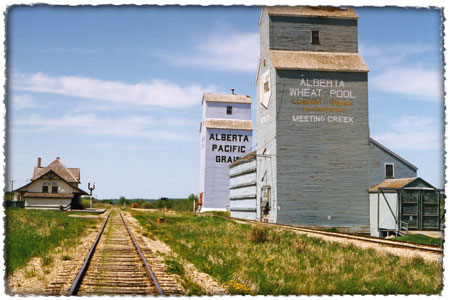 an art gallery, a library, and an archive. It is one of the largest museums in Canada, but is most recognized for being a cultural institute that embraces the many interesting historical artworks, artifacts, and documents of the Canadian West. Their official website - http://www.glenbow.org/ – provides prospective visitors with a myriad of information that explain their displays and program objectives.
an art gallery, a library, and an archive. It is one of the largest museums in Canada, but is most recognized for being a cultural institute that embraces the many interesting historical artworks, artifacts, and documents of the Canadian West. Their official website - http://www.glenbow.org/ – provides prospective visitors with a myriad of information that explain their displays and program objectives.Their mandate is “to promote and encourage the acquisition and diffusion of knowledge of the human race, its art, its history and the nature of the
 world in which it lives, in the manner that best serves the educational and cultural needs of Albertans.” Glenbow prides itself on their ability to preserve western culture as well as maintain standards of museum practice that both attract and retain “the best citizens for Calgary.” Being located in the heart of southern Alberta provides Glenbow with an audience that can both learn and contribute to their success.
world in which it lives, in the manner that best serves the educational and cultural needs of Albertans.” Glenbow prides itself on their ability to preserve western culture as well as maintain standards of museum practice that both attract and retain “the best citizens for Calgary.” Being located in the heart of southern Alberta provides Glenbow with an audience that can both learn and contribute to their success.In 2004, an exhibit was put together that would focus heavily on the museums mandate, goals, and abilities as mentioned above. Creatively and suitably titled ‘Capturing Western Legends’, it was a demonstration of the works created in the early 20th century by American artists Charles Russell and Frederick Remington. Their drawings, paintings, and sculptures stand as a marker for the fantastic Hollywood stories and legends based on the dominate frontier prairies of the past. These works have been so influential that today their iconic images hold strong cultural value when describing the Canadian West.
The first artist, Frederic Sackrider Remington (1861-1909), was born in New York and spent much of his life in Eastern America. In the 1880s he travelled
 west to Montana where he first experienced the thrill and beauty of the western frontier. Here he came to grip with his artistic talents and gained much success exploring and depicting the most profitable aspects of cowboy and Native American life. Employed by two growing American magazine publishers, Harpers Weekly and Colliers, he profited greatly enough to focus solely on painting and sculpture for income. Many of the works on display at the Glenbow museum were not created until after 1887 when Remington first ventured north into the Canada Rockies. These centre upon and depict the power and pride of the Canadian Mounties, the sensation of the Hudson’s bay company fur trade, and Native Canadian life as understood by citizens of the time period.
west to Montana where he first experienced the thrill and beauty of the western frontier. Here he came to grip with his artistic talents and gained much success exploring and depicting the most profitable aspects of cowboy and Native American life. Employed by two growing American magazine publishers, Harpers Weekly and Colliers, he profited greatly enough to focus solely on painting and sculpture for income. Many of the works on display at the Glenbow museum were not created until after 1887 when Remington first ventured north into the Canada Rockies. These centre upon and depict the power and pride of the Canadian Mounties, the sensation of the Hudson’s bay company fur trade, and Native Canadian life as understood by citizens of the time period.The Second Artist, Charles Marion Russell (1864-1926), was also American, born in Missouri, though settled within frontier lands of
 Montana at the age of sixteen. He first found a living as a rancher, only making sketches of the west in his spare time. He traveled to the Canadian west shortly after Remington had, in 1888. Here he spent much of his time with Native Canadians, learning of their lifestyle and creating numerous art works to record and explain his experiences. Russell gained a loyal audience within the members of the prairie west and was invited to exhibit his talent at Calgary’s first ‘Stampede’ in 1912.
Montana at the age of sixteen. He first found a living as a rancher, only making sketches of the west in his spare time. He traveled to the Canadian west shortly after Remington had, in 1888. Here he spent much of his time with Native Canadians, learning of their lifestyle and creating numerous art works to record and explain his experiences. Russell gained a loyal audience within the members of the prairie west and was invited to exhibit his talent at Calgary’s first ‘Stampede’ in 1912.These two famed artists, almost heroic idols for some, are popular for their representation of the Frontier. The significance of the ‘Frontier’ at the time of Russell and Remington is that it taught and enforced numerous morals and values that came to be glorified in the wild and lusty characters of Hollywood Western films. The harsh conditions and vast expanse of the Western region had turned the ‘boys’ into ‘men’ and the ‘men’ into leaders for centuries. As the 20th century and industrialism brought the Frontier to a close, the impact of art works from the men like Russell and Remington grew stronger as outlets to remind and teach new generations of their cultural past.
 Capturing Western Legends arrival at Glenbow museum allowed them to present to the people of the 21st century, the culture their ancestors had thrived upon. Though the two chosen artists for this exhibit are from the industrial urban east of America, one should not conclude that there weren’t any works created from within the Canadian West. The fact that these men, born in the lands they were, had become so fascinated and endeared to the western lands, can only enforce the value and attraction that these mystic ‘legendary’ lands contained.
Capturing Western Legends arrival at Glenbow museum allowed them to present to the people of the 21st century, the culture their ancestors had thrived upon. Though the two chosen artists for this exhibit are from the industrial urban east of America, one should not conclude that there weren’t any works created from within the Canadian West. The fact that these men, born in the lands they were, had become so fascinated and endeared to the western lands, can only enforce the value and attraction that these mystic ‘legendary’ lands contained.Below are two examples of the type of legends that came to life through the drawings, paintings and sculptures of Charles Russell and Frederic Remington. Though these myths are today mere pieces of the past, they still serve as major cultural conduits of Prairie and Canadian society as a whole, however highly elaborated and romanticised as they are.





















No comments:
Post a Comment